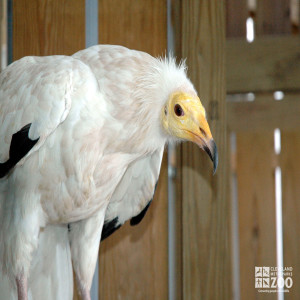Egyptian Vulture
[Neophron percnopterus]

The Egyptian vulture is white except for some black and gray flight feathers. The sexes are alike. The young bird in first plumage is brownish-black with fulvous tips to the feathers forming distinct patches of light color on the mantle, back, rump, upper and lower tail coverts. The young bird passes through an almost entire¬ly brownish-black phase during which the lighter colors vanish. After three moultings they become paler, eventually taking on adult's white plumage. The young of this species are often confused with young white-headed vultures and hooded vultures but there is no mistaking the adults with their bright yellow faces.
Location: Animals Formerly at Zoo
Share:
Range
The range of the Egyptian Vulture is Southern Europe, Africa east through Arabia to India and southwestern Asia.
Habitat
The Egyptian vulture inhabits mountainous rocky regions, hills, lowlands and deserts.
Conservation Status
EndangeredPrimary Threats
Human Wildlife Coexistence, Climate ChangeGestation
Approximately 42 days
Litter
1 or 2 at intervals of 3 to 4 days
Behavior
The Egyptian vulture, with habits similar to other vultures, is of considerable value as a scavenger. It is smaller than many other vultures and at a carcass must yield to its larger cousins. Their numbers have been much reduced lately.
Reproduction
The Egyptian vulture nest on cliffs, where available, otherwise on date palms or other suitable trees. The nest is an untidy heap of sticks, rags or any other material. They generally lay two eggs. Both sexes rear the young. The young vultures fly after 90 days or so, but do not seem to mature until 5 or 6 years old. When getting ready to nest, these vultures sometimes use old nests of other species in trees.
Wild Diet
Termites, carrion, locusts, dates, small mammals
